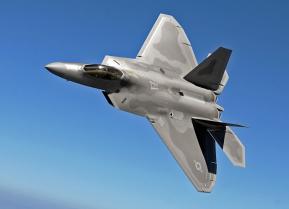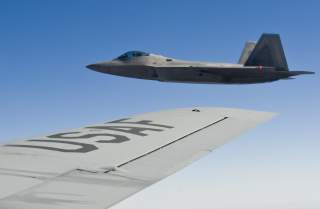How Russia Could Someday Shootdown an F-22, F-35 or B-2 Stealth Bomber
Here is the theory.
“Just because something is technically possible doesn't make it tactically feasible,” one Air Force official with extensive stealth aircraft experience explained.
As tensions between Washington and Moscow flare, the Russian military is warning the United States that it has the ability to target stealth aircraft such as the Lockheed Martin F-22 Raptor, F-35 Joint Strike Fighter and Northrop Grumman B-2 Spirit that might be operating over Syria with the Almaz-Antey S-400 (NATO: SA-21 Growler) and the recently arrived S-300V4 (NATO: SA-23 Gladiator) air and missile defense systems. However, Western defense officials and analysts are skeptical and note that both the F-22 and the F-35 were specifically designed to counter those Russian-developed weapons.
(This first appeared in 2016.)
"Russian S-300, S-400 air defense systems deployed in Syria's Hmeymim and Tartus have combat ranges that may surprise any unidentified airborne targets,” Russian Defense Ministry spokesman Major General Igor Konashenkov told the Russian state media outlet Sputnik. “Operators of Russian air defense systems won't have time to identify the origin of airstrikes, and the response will be immediate. Any illusions about ‘invisible’ jets will inevitably be crushed by disappointing reality.”
However, while Moscow makes bold claims about the counter-stealth capabilities of their S-400 and S-300V4 air defense systems, the fact remains that even if Russian low-frequency search and acquisitions radars can detect and track tactical fighter-sized stealth aircraft such as the F-22 or F-35, fire control radars operating in C, X and Ku bands cannot paint low observable (LO) jets except at very close ranges. Stealth is not—and never has been—invisibility, but it does offer greatly delayed detection so that a fighter or bomber and can engage a target and leave before the enemy has time to react.
Tactical fighter-sized stealth aircraft must be optimized to defeat higher-frequency bands such the C, X and Ku bands—that’s just a simple matter of physics. There is a ‘step change’ in an LO aircraft’s signature once the frequency wavelength exceeds a certain threshold and causes a resonant effect. Typically, that resonance occurs when a feature on an aircraft—such as a tail-fin or similar— is less than eight times the size of a particular frequency wavelength. Fighter-sized stealth aircraft that do not have the size or weight allowances for two feet or more of radar absorbent material coatings on every surface are forced to make trades as to which frequency bands they are optimized for.
That means that radars operating at a lower frequency band such as parts of the S or L band are able to detect and track certain stealth aircraft. But ultimately, to counter lower frequency radars, a larger flying-wing stealth aircraft design like the Northrop Grumman B-2 Spirit or the B-21 Raider—which lacks many of the features that cause a resonance effect—is a necessity. But at the UHF and VHF band wavelengths, designers are not trying to make the aircraft invisible—rather engineers hope to create a radar cross-section that will blend in with the background noise that is inherent to low-frequency radars.
Recommended: Forget the F-35: The Tempest Could Be the Future
Recommended: Why No Commander Wants to Take On a Spike Missile
Recommended: What Will the Sixth-Generation Jet Fighter Look Like?
Low frequency radars can be used to cue fire control radars however. Additionally, some U.S. adversaries have started to make an effort to develop targeting radars that operate at lower frequencies. However, those lower frequency fire-control radars exist only in theory—and are a long way off from being fielded.
“Stealth is ‘delayed detection’ and that delay is getting shorter. SAM (Surface-to-Air Missile) radars are shifting their frequencies into lower frequency bands where U.S. stealth is less effective,” said Mark Gammon, Boeing’s F/A-18E/F and EA-18G program manager for advanced capabilities, had told me some time ago. “Early warning radars are in the VHF spectrum where stealth has limited if any capability. These radars are networked into the SAM radars giving the SAM radars cued search.”
But low-frequency radars do not themselves provide a “weapons quality” track that is needed to guide a missile onto a target. There are various techniques that have been proposed to use low frequency radars for such purposes, but none of those are likely to prove viable. U.S. Air Force Col. Michael Pietrucha had described one possible approach to me to accomplish such a feat in an article I wrote for Aviation Week & Space Technology a few years ago. However, U.S. Air Force officials were dismissive of the technique. “Just because something is technically possible doesn't make it tactically feasible,” one Air Force official with extensive stealth aircraft experience explained.
Meanwhile, operational Raptor pilots tell me “it would be really classified to discuss specific SAM counter tactics,” however, the F-22 is more than capable of defeating any of the current Russian surface-to-air missile systems that are currently or projected to be fielded. Hopefully, we will not have to find out the how effective the Raptor truly is during a shooting war over Syria—since conflicts can rapidly escalate out of control, as history loves to teach us over and over again .
Dave Majumdar is the former defense editor for The National Interest.


